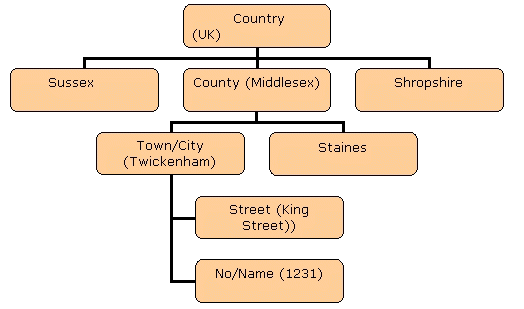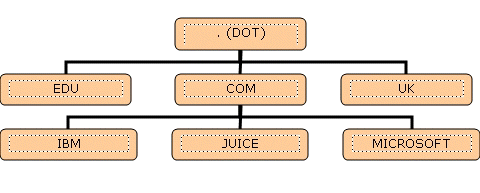Before you can start choosing, and using domain names it is useful to have an idea of how domains are structured, and what parts of the name are fixed and what parts you can choose yourself.
As an aid to explaining domain names and to help you to understand them we will compare them to something everyone is already familiar with.- your house address.
If we examine a standard house address you see that it is divided into:
house name/No, street address, town or city, county, country i.e. 1231, King street, Twickenham, Middlesex, UK.
The address has a structure which is hierarchical starting at the top with the country. Figure 1 shows this structure.

Figure1: Structure of Typical house address
A domain name is used to identify a Website in the same way as your house address identifies your house.
If we examine a fully qualified domain name (FQDN) i.e. www.juice.com in more detail then
www = name of server (physical machine)
juice.com = domain name (note: doesn’t include the server name)
and juice = sub domain of com and com= Top level domain name
The domain name structure is a hierarchical structure just like the house address.
The top of the structure however is not the Country name but a dot (.).
When entering a domain name into a browser it is normal to omit the dot(.).
In which case it is inserted automatically by the web browser,and most people are totally unaware that it is there.
Underneath the dot are what are known as the top level domains (TLDs) which are strictly controlled (e.g..com, .net, .UK)
.
Underneath the top level domains are second level domains like IBM,
Microsoft and Juice in our example.
This second level name is typically the name of an organisation, and control over this name is given to that organisation,
The organisation can then divide it into third level domains as it wishes.
At any level a domain can contain sub domains or computer names (i.e. www).
The structure is shown in figure 2.

Figure 2 Domain Name system Hierarchy
As another example for those familiar with the standard file system found on computers.
A domain is equivalent to a folder and a computer name equivalent to a file and a folder can contain either a file or a folder.
To completely define the location of a file you have to specify all of the
folders, and you write it like this c:\examples\index.htm.
A FQDN (fully qualified domain name) is similar except we write it from bottom to top – www.juice.com.
A domain name can be considered to be a company or organisational name.
The domain name doesn’t include the server name (www)
If we compare this with our house address then the domain name is equivalent to specifying an address as far as the street name, but doesn’t include the house number/name.
If we include the house number/name (server name) then this is called the fully qualified domain name (FQDN).
When applying for a name you apply only for the domain name (street name) and you can call the servers/hosts/websites anything you want.
It is like being a property developer who builds a housing estate. He applies for the street names to the local authority, and he names or numbers the houses as he wants.
Why is it always WWW?
If this is the case then why are all our Web servers named www? .
The use of www is simply a convention on the internet so as to make it easier to remember the Web addresses –but they don’t have to be.
You may find that some private sites deliberately choose another name for the server so as to discourage uninvited visitors.
You will also find that it is possible to omit the www and still access the website.
In this case the DNS system effectively inserts it for you.
Domain Name Uses
Currently the two main uses are Websites and email.
- Website addresses take the form WWW.domain name
- Email addresses take the form mailbox@domain name
TLD’s Top Level Domain Names
The top level domains (TLDs) are divided into two groups
- –non geographic (.com, .edu, .gov, .int, .mil, .net, and .org) and
- Geographic using a country code (.uk, .de, .ca).
The non-geographic TLDS (.com, etc) were the original seven names assigned before the Internet become popular.
Domain name extensions in three of these (.com, .net, and .org) could be registered without restriction; the other four have limited purposes, and were/are restricted.
The result is that the three domain name extension .com, .net, .org are now the most commonly used on the Internet.
Originally the Internet was a totally USA affair and hence there was no need for any geographic names.
This all changed in the 1990s as the Internet spread to The rest of the world and the Geographic TLD extensions were introduced.
These are based on existing International country code standards e.g. .uk for United Kingdom and .de for Germany (Deutschland) etc.
Because of increased demand for names, especially non geographic, seven new non geographic TLDS were decided on and introduced in 2001 and 2002.
They are (.biz, .info, .name, and .pro, .aero, .coop, and .museum).
Since then other new TLDs have been introduced, and are in the process of being introduced like .london, .pub .
What is not known is how popular these alternate TLDs will become.
You can find more details on these new domain names here.
Video
For those you prefer video here is a three part video series.
http://youtu.be/zVIxXmSX3VI
http://youtu.be/FqWmWaaKtyI
http://youtu.be/yPyT-2-4uOc
Related Articles:
